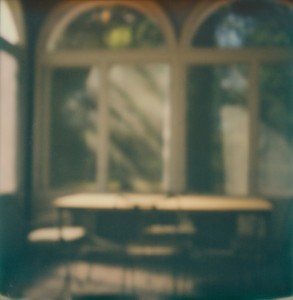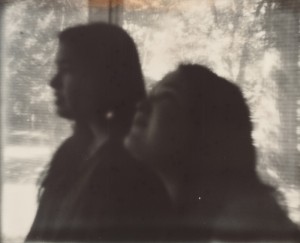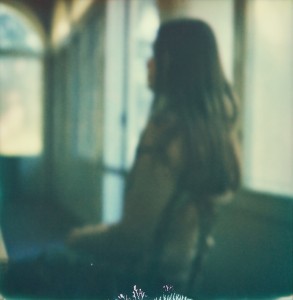Kilo: A Tangle of Both Arbitrary and Significant Arrangements
Eva Diaz

Kilo #27
There’s a lovely forty-acre park in western Massachusetts dedicated to quiet contemplation, created almost seventy years ago with the help of a rich donor. The park has formal rose gardens as well as wild, pine woods dense with ferns. There are few structures on the site: two barns and a carriage house, and an Italianate garden pavilion with a red tile roof, beige stucco walls, and half round window arches supported by simple white columns. This building, called the Tea House, has stood unoccupied for decades, though it remains well maintained. Passing its glass-enclosed sunroom one can almost hear the murmur of garden party chatter, the clinking of crystal glasses, and the rustle of silk floral dresses.
For years photographer Susan Mikula has visited this park near her home. Passing the vacant pavilion, Mikula’s curiosity about the structure was piqued, and she imagined entering it. Because she’s a photographer, fantasies about crossing its threshold became wedded to how she would record that encounter.
Photography can document the world as it seems, or it can fashion a world that seems real. What could transpire inside this structure? How could one represent this space, a place so infrequently used and yet so beautifully preserved, a site sitting dormant but expectant, as though it were a set waiting to be populated?
Mikula employs Polaroid cameras, chasing down the now discontinued and difficult to obtain dead-stock film the cameras employ. Mikula uses the character of this older instant film stock, which produces images that often suffer fading, blurring, and chemical inconsistencies in the emulsion that lead to spotting, rippling and other visual distortions. Though sometimes she displays the small Polaroids alone, in most cases she enlarges the images and produces color prints in larger formats. By increasing the scale of the images from the hand-sized Polaroids the flaws in the originals are more evident, mapping a series of translations in which the ostensibly indexical quality of photography—a document of light conditions falling on objects at a particular time—becomes an impression of a moment, warped first by insufficiently fixed chemicals and then by the deformations caused by the enlarged scale.

Kilo #17
An archaic technology, and an antiquated architecture. How better to disrupt all this pastness than to introduce teenagers? Perhaps a couple: a girl in a lilac print sheath, the other in a blue rose chiffon made wide under layers of crinoline, both in white hats and gloves? No. Teenagers of long ago will not do. Polaroids and this Tea House building were once young together, but now no more. So too with teens of that mid-century past. Mikula instead chose a pair of contemporary girls, sisters, brunettes with long curtain-like hair parted in the middle, a perennial hairstyle somehow fitting the black and white, sepia, or pale blue and yellow photographs taken with film that looks old even in a “new” photograph taken today. Mikula asked these teenagers, daughters of a family friend, to model for a mere two-hour shoot.
Winnowed down to thirty-one images from two hundred, not all of the pictures contain the pair, nor are the girls always together when shown. Some images capture the architectural features and décor of the Tea House—its patterned curtains, sconces, dining table and chairs, even its bathroom, and of course the distinctive semi-circular windows that rim the structure. Due to the intentionally ambiguous blur of the shot, and the manner in which exterior light filters in as a kind of second aperture, it is sometimes difficult to make out precise details in the work.
This blur calls into question the manner in which a camera sees the world differently from human vision; challenging the positivist claim that the technical apparatus of photography can represent reality as a set of authentically “true” documents. Put another way, viewers’ perceptions are mediated by the way the blur and distortions of Mikula’s photographs cast doubts on the truth ascribed to the retinal fact of apperception. As humans we think we understand the world because we see it with such immediacy, with such ease. All we do is open our eyes, and the world appears to us.

Kilo #38
But what comes to sight so instantly is in actuality an enigmatic labyrinth, a tangle of both arbitrary and significant arrangements. All forms captured by the camera have both visible and invisible histories and meanings, all the more so the individuals whose luminous surfaces reflect light back to the camera’s lens, which then fixes these surfaces on a light sensitive negative. In Mikula’s case the ambiguity of her images, their blur and imprecision, emphasizes that the visual appearance of the world developing in the film is simultaneously contingent and selectively constructed.
Mikula’s body of work at the Tea House is titled “Kilo,” a seemingly incongruous name. In actuality Mikula refers to all her series with the so-called NATO alphabet, the military code familiar in aviation as Alpha, Bravo, Charlie, Delta, and so on. Yet this is the only series in which she has publicly assigned the work the title of her internal designations. She made this exception because the NATO alphabet is also the International Code of Signals—the flag semaphores used in maritime communication. The “kilo” flag, a square divided vertically into yellow and blue halves, means “I want to communicate with you.”
Who flies the flag? Who is the subject “I” who wishes to communicate? Together the Tea House, the girls, and the photographer form a new “I”: the “I” of the photographs themselves. But what they want to communicate is a more complex question. So rarely do we commune with images; we frequently treat them as just another immediately apperceived set of arrangements glanced over by our wayward eyes. “Kilo” invites us to instead truly perceive and cogitate upon the world when it offers us framing experiences, those experiences we call art. That is to say, the experiences that arrest sight and allow us to attend to details within the plentitude of our vision.
Eva Diaz, New York, April 2017
Eva Díaz lives in Rockaway Beach, New York. She is Associate Professor of Contemporary Art at Pratt Institute in Brooklyn.
